Pansy jelly is a light spring floral jelly made with edible pansy flowers. All violas are edible, both cultivated and wild, and this recipe works well with garden pansies as well as wild violets.
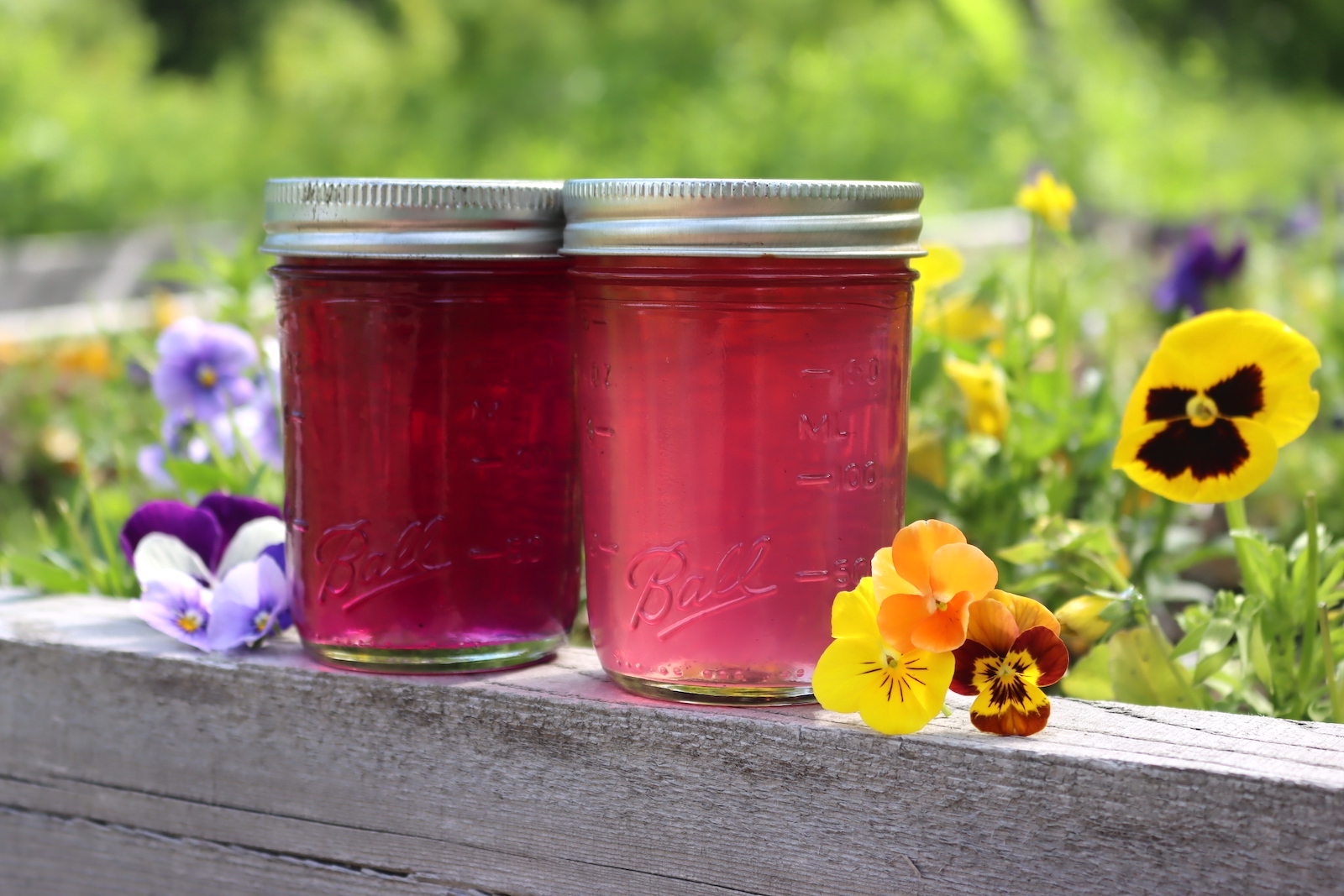
Pansies are one of the first garden flowers of spring, and every year, my daughter spots them at the garden store with excitement. They tolerate frosts, and they flower long before most of our garden staples are even planted.
I love them for their bright color each year, before the grass has even greened up for the season.
But they also have an extra treat to share…
Pansies are edible!
These lovely spring flowers work perfectly tossed into salads or made into candied flowers for topping treats. They’re also absolutely wonderful in a homemade pansy jelly.
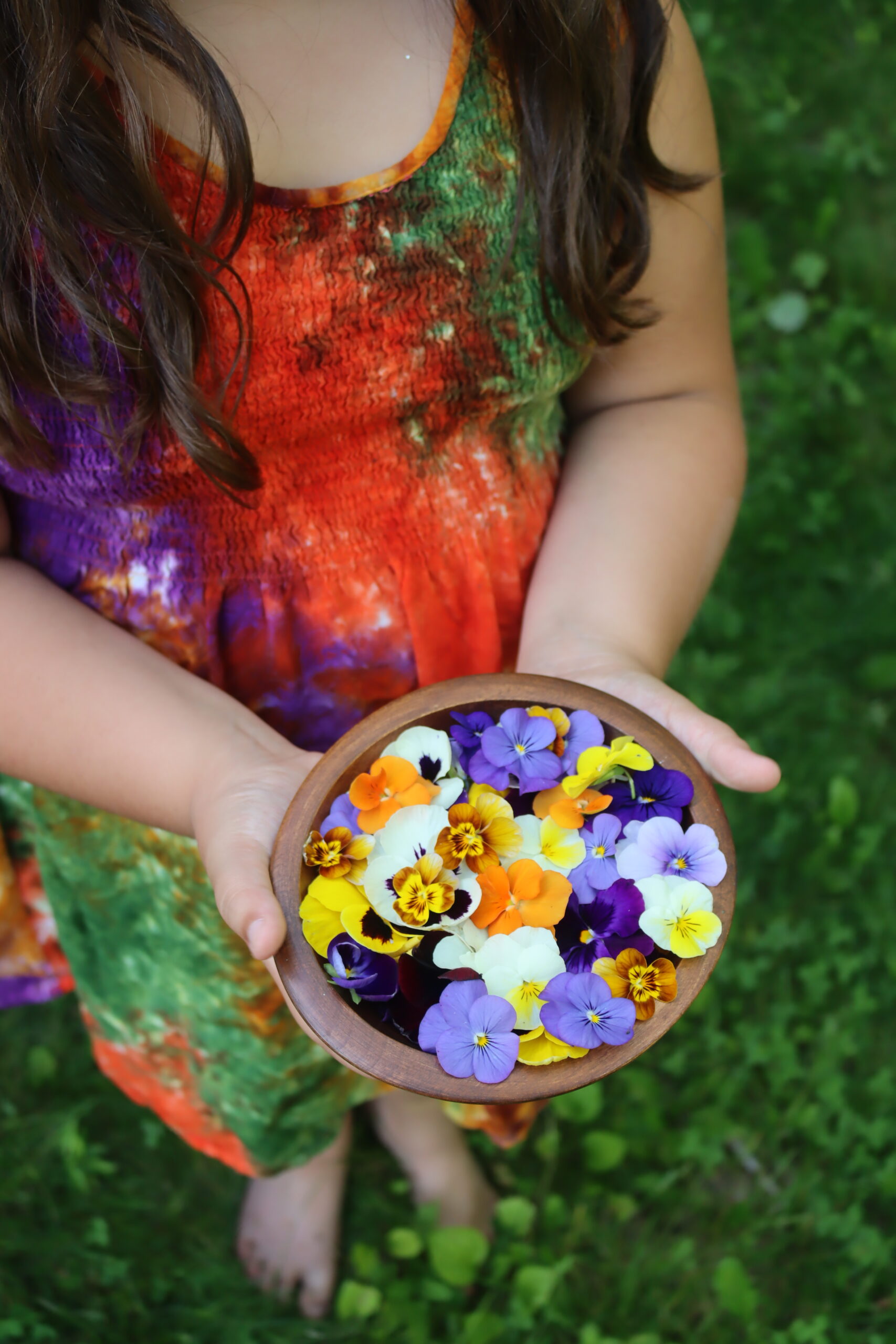
All species of viola are edible, both wild and cultivated. We’ve made wild violet jelly in the past, but the flowers are so small that it can take all afternoon to collect enough for a batch.
The same goes for “Johnny Jump Ups” (Viola tricolor), which dot all the shady spots in our yard and garden paths.
This year, we tried our hand at making a simple pansy jelly with the edible pansies growing in our flower beds, and the results were just as magical. It tastes just as wonderful, but the flowers are much larger and more prolific, meaning you can harvest enough pansies for a batch in minutes (rather than hours).
Harvesting Pansies For Flower Jelly
Generally, when I’m making a flower jelly, I like to harvest the blossom directly into a mason jar. The jars are heat proof, so I can use them for making the flower tea, and I know exactly when I have enough.
For a “batch” of flower jelly that uses 1 box of pectin, you’ll need about 4 cups of flowers (loosely packed). That’s one-quart mason jar full. (And likewise, a half batch is a pint jar, or a quarter batch is a half pint.)
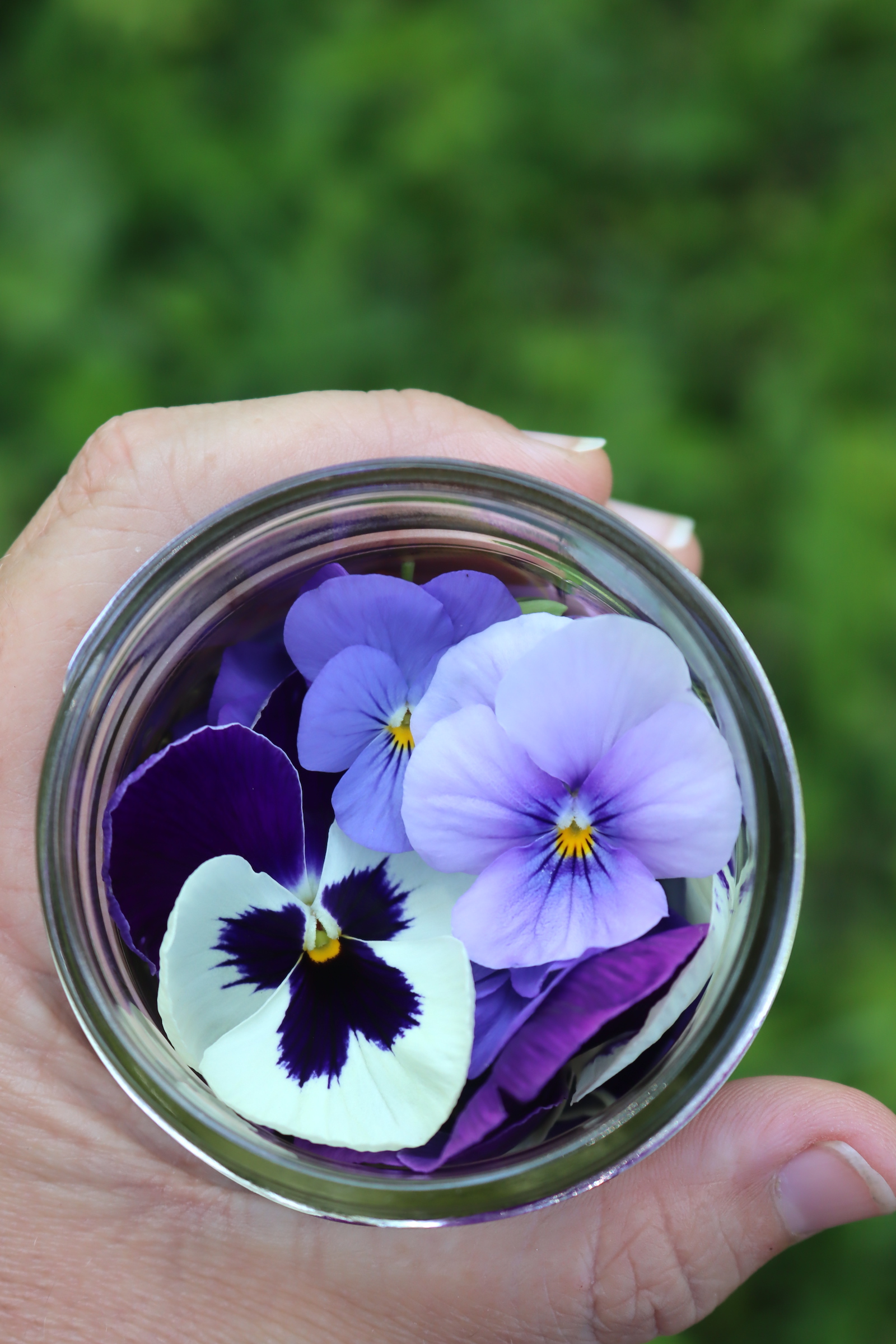
I collected the pansies in jars based on color, since I wanted to know if I’d get different colored jellies (or different flavors) from the various pansies growing in our flower beds.
Pansies come in all manner of colors, from bright yellows to a purple so dark that it’s almost black.
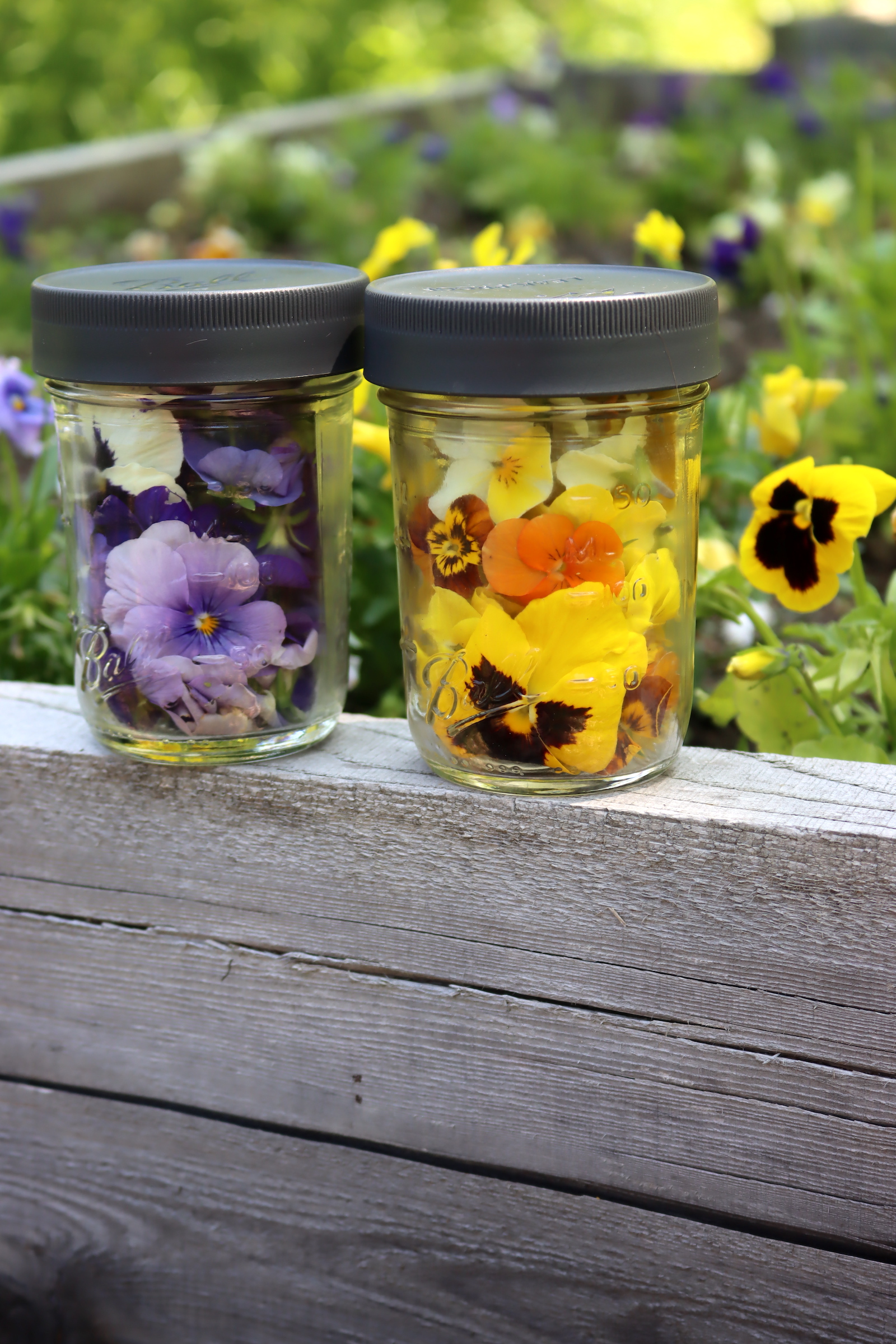
When you actually make a pansy tea for jelly though, they all come out a turquoise color. Lighter flowers will yield a lighter color, and darker flowers a darker color, but it’s all turquoise.
When you add lemon juice (or citric acid) to make the jelly, that turquoise pansy tea will turn purple-red to pink. That’s true even if you have orange or yellow pansies. All of them make pink, red, maroon, or purple pansy jelly.
Don’t be surprised by the blue-green tea you get at the start, though. That’s normal.
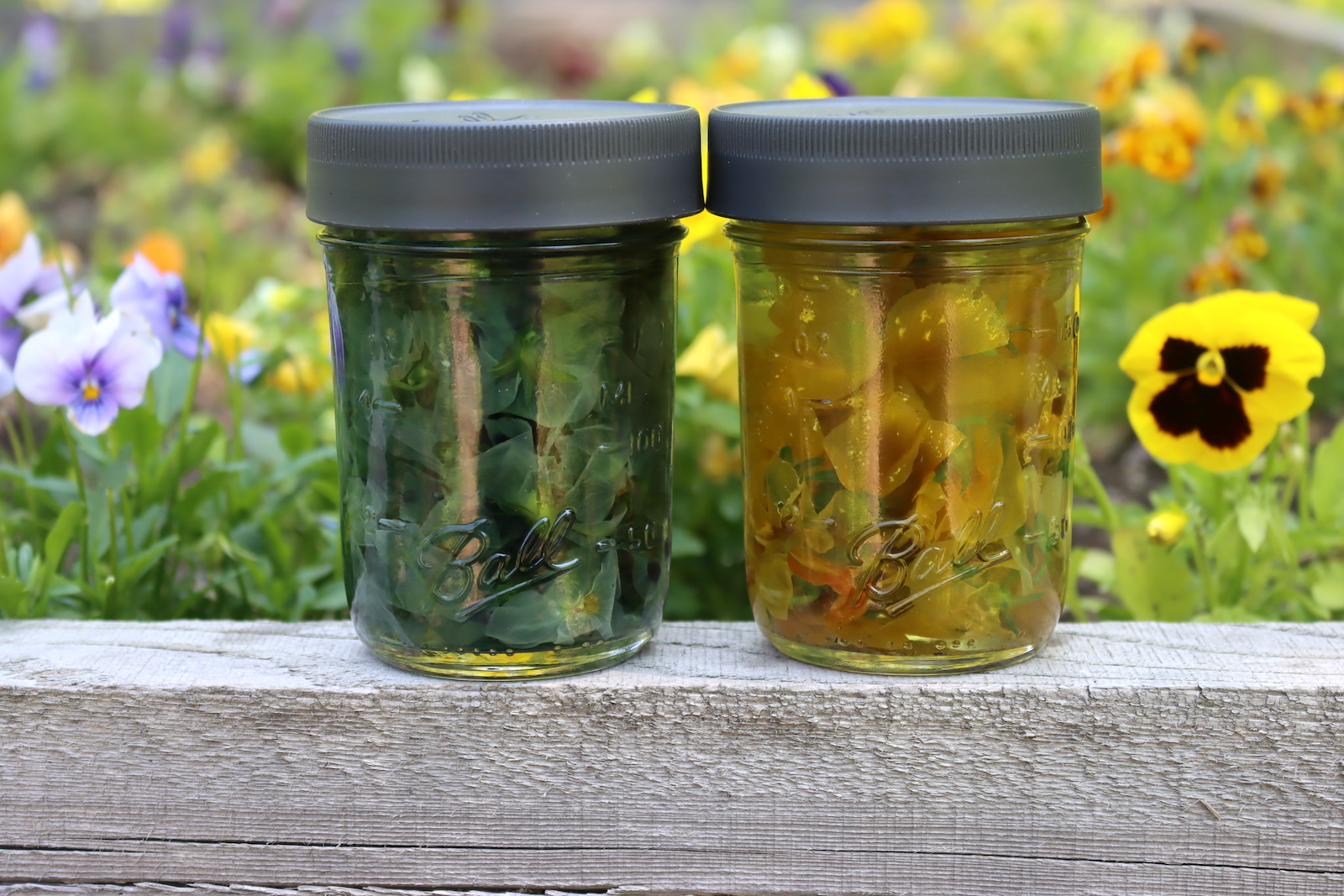
What does Pansy Jelly Taste Like?
The same compounds that give pansies their color also give them their flavor. Those pink/blue color compounds are similar to the color compounds in blueberries and strawberries, and believe it or not, pansy jelly tastes like fresh spring berries.
With a little lemon juice in there to bring out the color and add acidity, the effect is quite convincing, and you can have a “fruit” jelly long before the first fruits of the season.
The fragrance of the flowers comes through a bit as well, so it’s like berries with a light floral aroma.
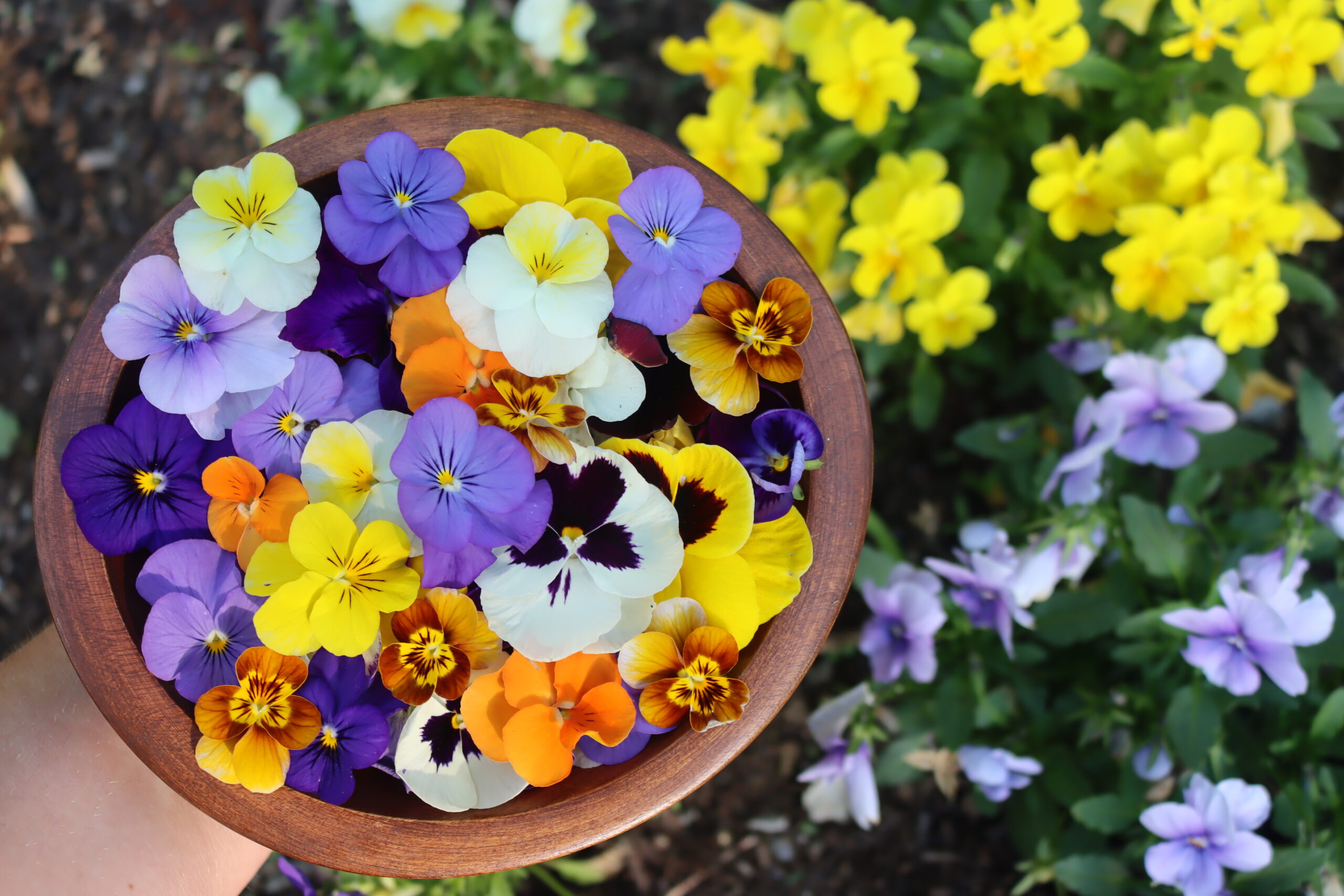
Ingredients for Pansy Jelly
To make a flower jelly from pansy flowers, you’ll need freshly harvested blooms, plus water, sugar, pectin, and a bit of lemon juice.
For a 4 to 5 jar batch (8 oz each), you’ll need the following:
- 4 cups pansy blossoms
- 4 cups water
- 2 tbsp lemon juice (or ½ tsp citric acid)
- 1 to 4 cups sugar *see note
- 1 box (1.75 oz) pectin (Regular or Low Sugar)
If you don’t have quite enough flowers, you can make a half batch with 3 Tbsp of pectin (a full 1.75-ounce box is 6 Tbsp).
Or, just use 2 cups of flowers and have a lighter flavor and color.
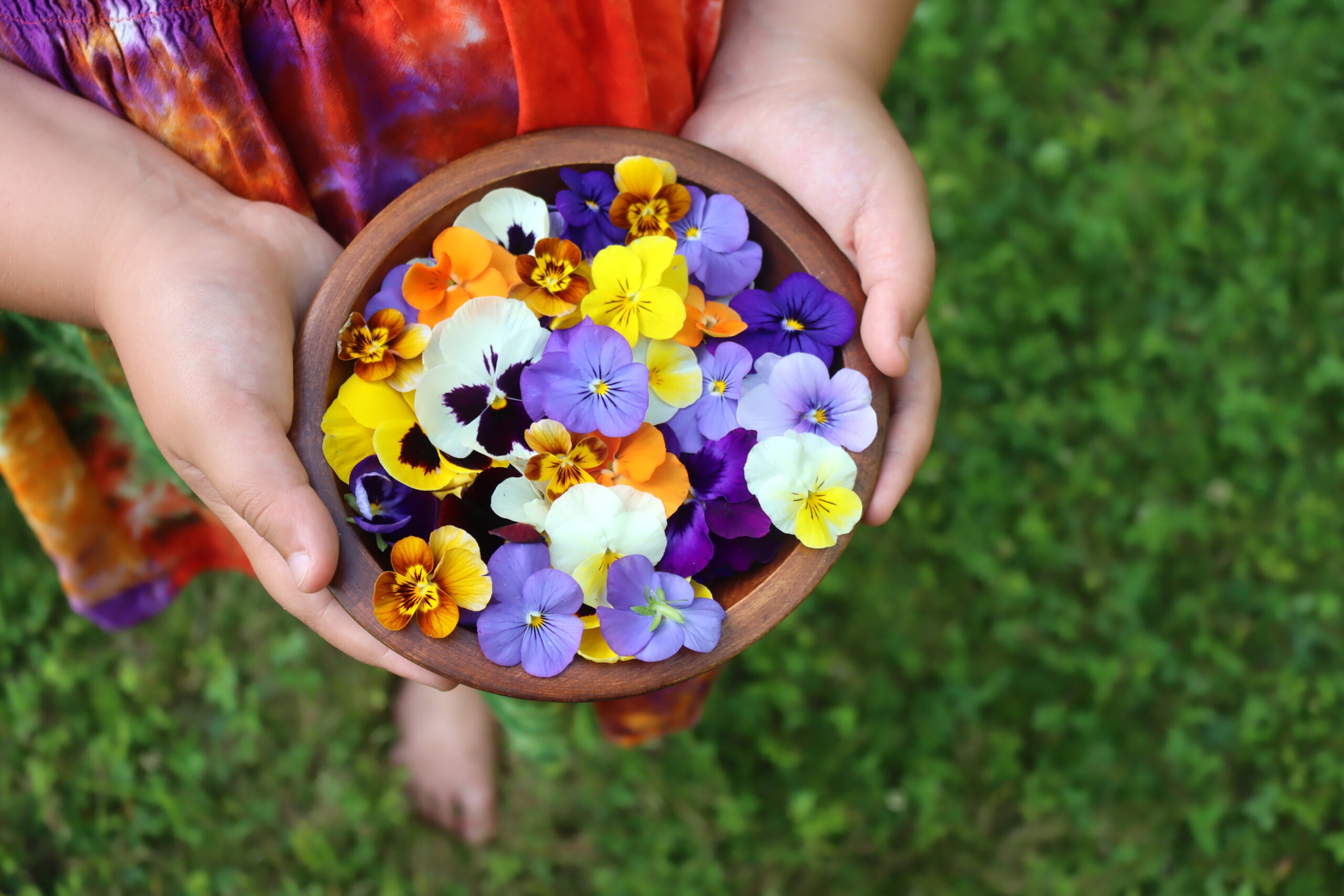
The lemon juice helps balance the flavor of the sugar, adding a bit of tart contrast to bring out the flavor of the flowers. It also lowers the pH, which helps the pectin set, and also preserves the jelly and makes it safe for canning.
Even if you’re not canning the jelly, you do need lemon juice. If you want a more neutral flavor instead, you can use citric acid powder (dissolved in a bit of water).
Citric acid granules are much stronger than citrus juice, and they’re used at a rate of 1/4 teaspoon of citric acid in place of each Tablespoon of lemon juice (or lime juice) in a recipe.
This recipe has 2 Tablespoons of lemon juice, so you’d need 1/2 teaspoon of citric acid per batch.
For pectin, I generally use sure jell or sure jell low sugar pectin, as they’re really dependable and result in the best texture in my opinion. (I’ve tried just about every type of pectin on the market.)
For regular sure jell pectin, you’ll need to add a minimum of 4 cups of sugar because it’ll only jell with a 1:1 liquid to sugar ratio. Sure jell low sugar will gel with any amount of sugar, and you can use as little as 1/2 cup for a barely sweet jelly. I’d suggest using 1 to 2 cups for a lower-sugar recipe that’s still sweet enough.
(Sure jell low sugar can also be used with full sugar recipes, so that’s what I usually keep on my shelf because it works great regardless of the sugar you choose.)
If you have Ball Flex Batch Pectin, you’ll need 6 Tbsp. (which is equal to a 1.75 oz box of other types of pectin). That’s true for their regular and low-sugar canisters.
The recipe card below also has instructions for liquid pectin, which requires astronomical amounts of sugar (7 cups sugar to 4 cups liquid). I don’t use it, but some people prefer that type of pectin, so I’ve included it just in case.
How to Make Pansy Jelly
Making jelly from pansies is the same as any homemade flower jelly. The process is the same with other edible flowers, including calendula, elderflowers, roses and more.
You’ll need 2 to 4 cups of fresh blossoms, but for pansy jelly, I think it works better if you use the full 4 cups. I like to pick them directly into a quart jar because it’s just the right size for the next step, which is steeping in 4 cups of boiling water.
Steep the pansies for about 15 to 20 minutes, and then strain.
Don’t be surprised when the tea is blue/green; it’ll turn pink to purple when you add the lemon juice.
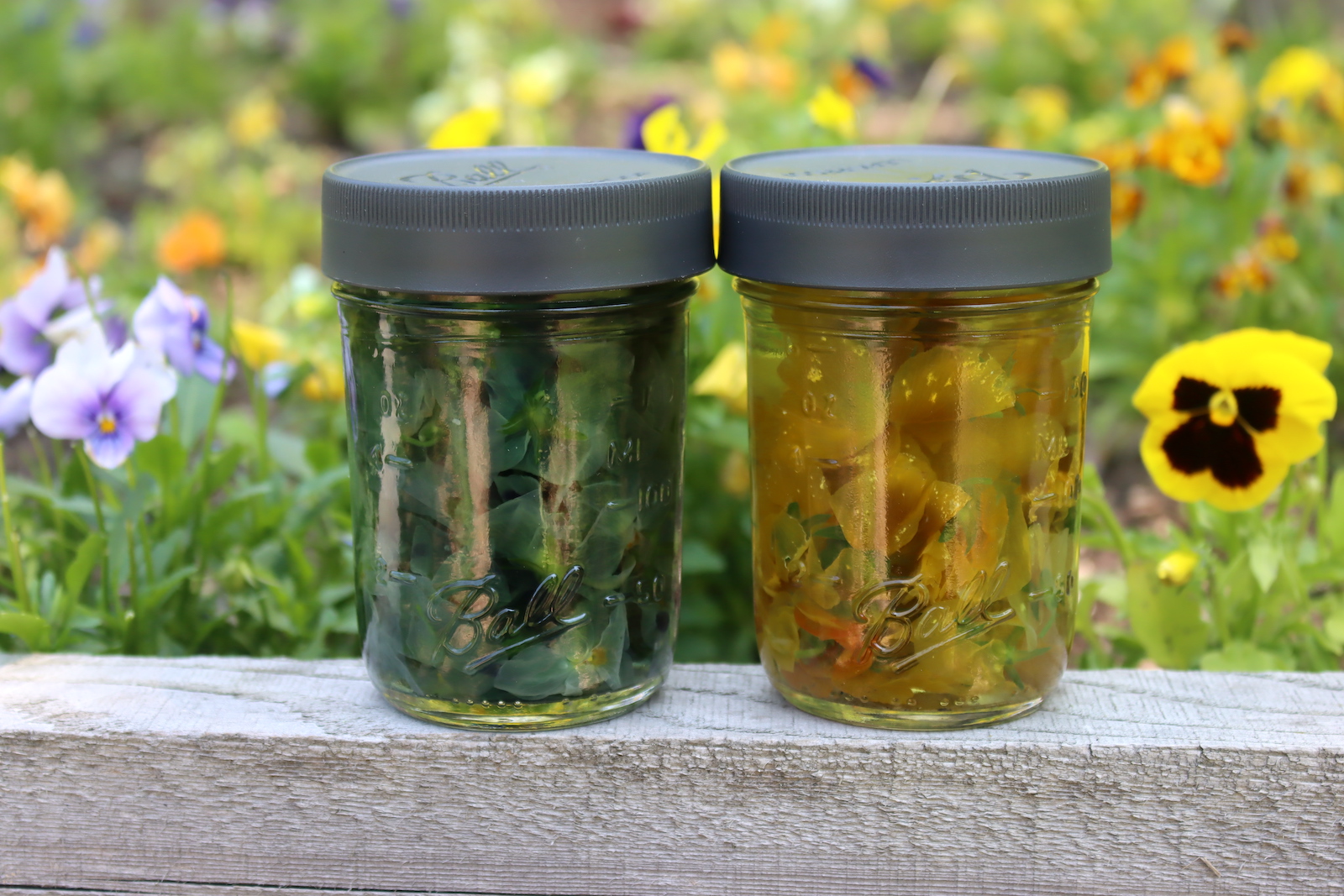
Pour the pansy tea into a jelly pot and add two tablespoons of lemon juice. (The lemon juice balances the sweetness from the sugar, and also makes the jelly safe for canning. I’d recommend it even if you’re not canning your jelly.) Next, bring the tea to a boil.
Add in one box of powdered pectin. (I use sure jel generally, but any standard 1.75 oz box of pectin will work.)
Stir in the pectin until it’s completely dissolved, and boil for 1 full minute.
Next, add the sugar. Standard pectin requires a 1:1 ratio of sugar to liquid to gel. Since we’re working with 4 cups of pansy tea, you’ll need 4 cups of sugar.
If you use a “low sugar” pectin, such as Sure Jel low sugar, then you can use as little sugar as you’d like. For a very low sugar jelly, you can use as little as 1/2 to 1 cup sugar to 4 cups pansy tea.
After you’ve added the sugar, stir to completely dissolve and return the mixture to a hard boil on the stove for 1 minute.
After 1 minute, remove the mixture from the heat and ladle it into prepared jars.
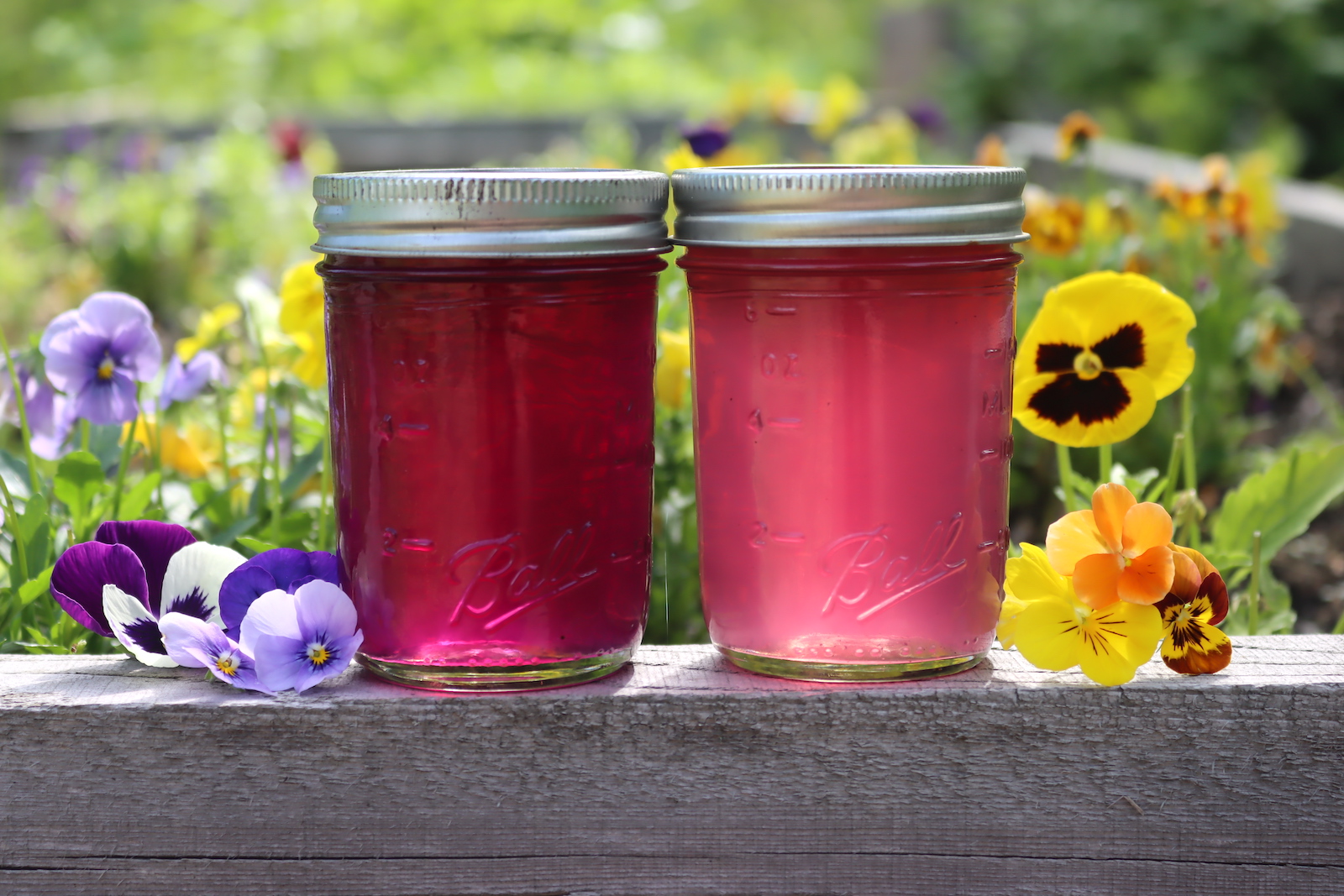
Canning Pansy Jelly
Canning this floral jelly is optional, and you can simply store it in the refrigerator, where it’ll last several weeks. Freezing is also an option, provided you’re using freezer-safe jars.
Personally, I like the simplicity of processing the jars in a water bath canner because it allows me to store the jelly right on the pantry shelf year-round. I can have the sweet berry-like flavor of pansy jelly any time of year, and it does not take up refrigerator or freezer space.
To can this jelly, be sure you’ve used lemon juice, which lowers the pH of the mixture enough for canning.
Prepare a water bath canner, canning jars, and lids before you start making the jelly. Make the jelly as otherwise, but then ladle into prepared canning jars leaving 1/4 inch headspace.
Seal the jars with 2 part canning lids and then process for 10 minutes in a water bath canner (15 minutes if above 6,000 feet in elevation).
Once the canning time is complete, remove the jars to cool on a towel on the counter. Properly canned and sealed jars will maintain quality on the pantry shelf for 12-18 months. Refrigerate after opening.
Pansy Jelly Variations
I think pansies have a wonderful flavor on their own, but they also combine well with dandelions for a dandelion petal pansy jelly. Dandelion petals taste like honey, so you’ll get a honey-berry taste. (If you haven’t made dandelion jelly, you should; it’s amazing!)
The 1988 Book On Flowers by Kleinman & Slavin suggests making lavender jelly, but using pansies for color. Lavender has an intense flavor, but it doesn’t give jelly color like pansies do. If you use a few cups of pansies, along with 1 Tbsp of lavender, you’ll get plenty of luscious colors as well as more than enough lavender flavor.
In that variation, though, you won’t be able to taste the subtle flavor of the pansies since the lavender is so fragrant.
Pansy Flower Recipes
Looking for more ways to use pansies?
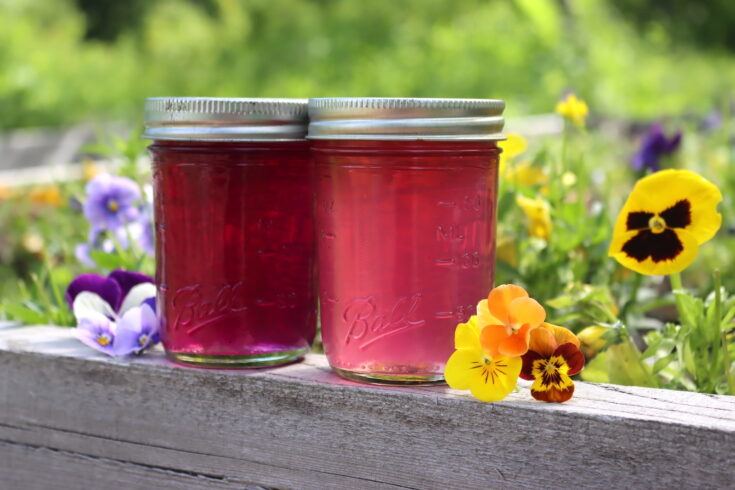
Pansy Jelly
Pansy jelly captures the fresh spring berry flavor of pansies sweet floral jelly.
Ingredients
- 4 cups pansy blossoms
- 4 cups water
- 2 tbsp lemon juice
- 1 to 4 cups sugar *see note
- 1 box (1.75 oz) pectin (Regular or Low Sugar)
Instructions
- Harvest 4 cups of pansy blossoms into a heat-proof container. (No need to remove the sepals of bases, they are edible as well, and taste fine without the bitterness that you'll find in the sepals of other edible flowers).
- Pour 4 cups boiling water over the top of the flower blossoms and allow the tea to infuse for about 10 minutes.
- Strain the floral tea into a saucepan or jam pot. Add the lemon juice, which will help bring out the best color in the jelly, but it's also required to balance the sugar in the recipe and help the pectin set. Beyond that, it adds acidity to help preserve the jelly, so don't skip the lemon!
- Bring the mixture to a boil and add the powdered pectin, stirring to dissolve. Allow the mixture to boil for 1 minute before adding sugar. (Note: Do not add the sugar at the same time as the pectin, or before the pectin, or the jell will not set.)
- Add the sugar, stirring to dissolve (See notes on quantity). Bring the mixture back to a full boil for 1 minute before ladling into jelly jars leaving 1/4 inch headspace.
- If canning, process in a water bath canner for 10 minutes. Otherwise, allow the jars to cool completely on the counter before storing in the refrigerator (for up to a month) or the freezer for up to 6 months.
Notes
Please be sure that the blossoms you use for jelly are, in fact, edible flowers, as not all flowers are edible varieties. Only used unsprayed flowers (no herbicides or pesticides) that were harvested from clean locations (ie. not roadsides or drainage ditches).
Beyond that, it's always possible to react to new foods, so please be careful when making big batches of things you've never tried before.
Many flowers are medicinal as well as edible, and while the quantities used in jelly generally aren't considered a "therapeutic dose," be sure that their actions don't conflict with any health conditions you may have. For example, hawthorn blossoms are used in blood pressure preparations, and violet blossoms are mildly diuretic.
Do a bit of background research on the particular blossom you've chosen.
A note on sugar...
If using standard pectin, you must use a 1:1 ratio of liquid to sugar. That means for 4 cups flower blossom tea you'd need a minimum of 4 cups sugar to get the jelly to set. That results in a very sweet "old-fashioned" jelly. To reduce the sugar, simply use low-sugar pectin instead and then make the jelly as instructed but using less sugar. I suggest sure jel low sugar, which is very dependable.
Lowering sugar will also lower yield, and the yield of 5 half-pints is for a full sugar recipe.
If using Pomona's Universal Pectin, the instructions are different, as that is a 2-part low sugar pectin. Follow the instructions provided in the Pomona's box for mint jelly.
If using liquid pectin, the order of operations is different (pectin is added last, sugar first). Liquid pectin also requires a lot more sugar to set (7 cups sugar to 4 cups liquid). I don't recommend liquid pectin because of the high sugar levels required for set, but it will work if that's your preference.
If you have Ball Flex Batch Pectin, you’ll need 6 Tbsp. (which is equal to a 1.75 oz box of other types of pectin). That’s true for their regular and low-sugar canisters.
Flower Jelly Recipes
Stock your pantry with these tasty floral jellies!
Herbal Jellies
Flowers aren’t the only plants in the garden that make wonderful jellies!
- Savory Herbal Jelly
- Lemon Balm Jelly
- Calendula Jelly (Marigold Jelly)
- Mint Jelly (coming soon)
- Tulsi Jelly (coming soon)
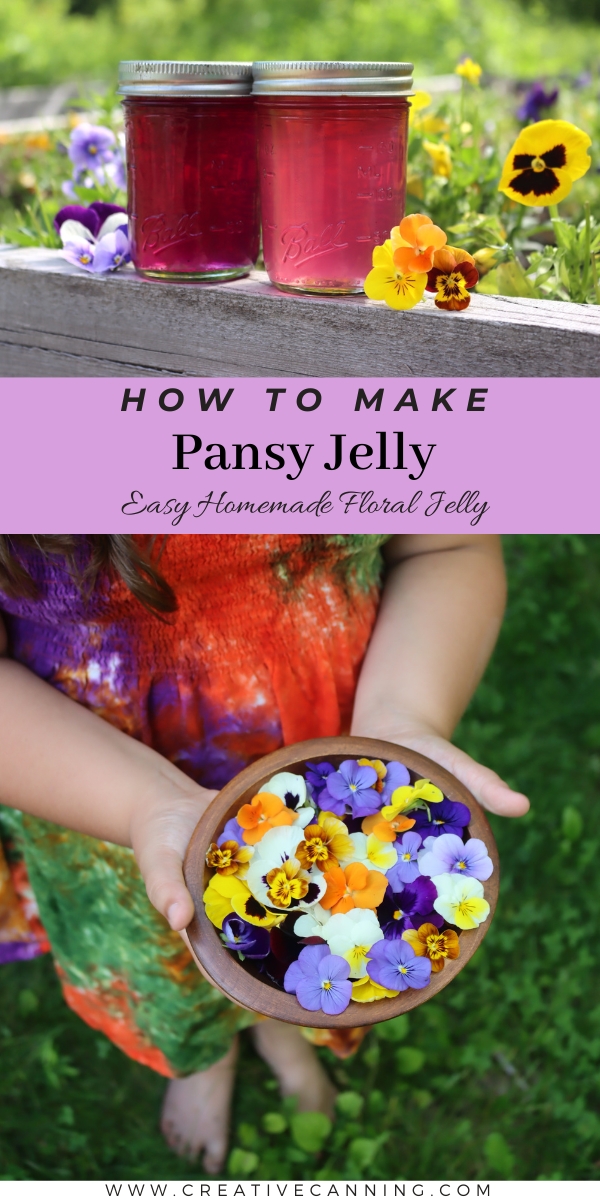
Leave a Reply